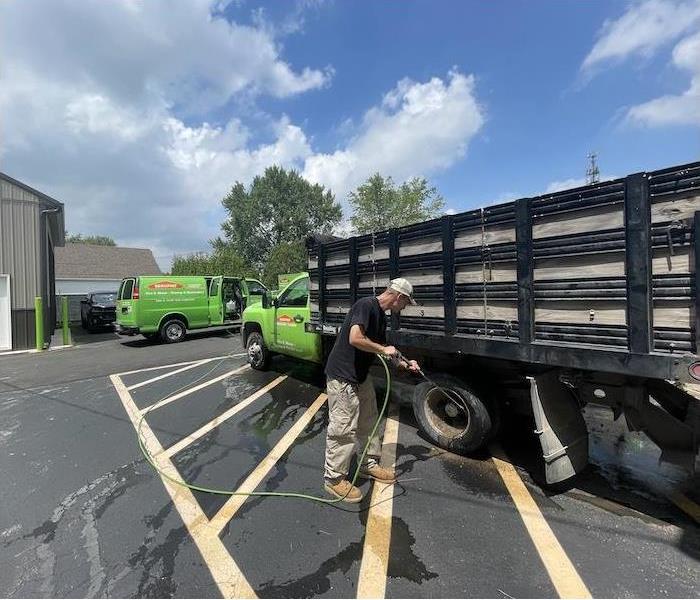What Steps Should Newark Homeowners Take After Water Damage?
3/30/2023 (Permalink)
 Our SERVPRO team keeps our equipment and trucks ready to help you with water damage in your Newark home.
Our SERVPRO team keeps our equipment and trucks ready to help you with water damage in your Newark home.
Newark Residents Can Contact Insurers and SERVPRO for Water Damage Claims and Restoration
Home water damage, regardless of the source, can prove distressing. Plumbing incidents and appliance leaks are among the most common culprits of such incidents. Newark property owners can contact their insurer to send a claims adjuster, document damage with photos and videos, shut off water and electricity if needed, and get in touch with a professional cleanup crew to perform repairs.
Newark SERVPRO water cleanup technicians use sophisticated tools and comprehensive water damage education to perform repair and replacement services for homeowners. SERVPRO also documents moisture effects on structures and contents and takes inventory of affected items per room to assist homeowners and insurance adjusters during claims filing.
How Homeowners Can Respond to Water Damage
While typical water damage scenarios are not large-scale disasters that fill a property with ample moisture, fast action is prudent. Even small leaks can compromise such structural components as:
- Wall cavities and insulation
- Electrical components and baseboards
- Carpet, floorboards, and subflooring
- Ceilings and ceiling joists
- Cabinets and counters
Contacting the insurer after discovering water damage is a must for receiving appropriate compensation per a homeowner's policy. Occupants do not typically wait for an adjuster to arrive before contacting moisture remediation professionals.
After discovering ongoing moisture exposure that might affect electrical components, homeowners are encouraged to contact utility providers for guidance on shutting off water and electricity temporarily. This measure can prevent further damage and minimize safety concerns from wet electrical wiring or outlets. However, it may be safer to have a utility provider send a professional to perform this service in some cases.
Mold and microbes can grow in as little as 24 to 48 hours after water damage begins. The risk of mold or mildew proliferating in a way that can impact structures is significantly reduced when homeowners contact technicians within 24 hours after discovering moisture. Depending on its extent, drying in many water damage situations may take only a few days.
Homeowners are encouraged to document the cleanup process before, during, and after restoration for their proof of loss claim. SERVPRO's inventory documentation, photographs, and video footage can also help with claims filing.
Removing Moisture from Carpet with Hot Water Extraction
For residential moisture damage, there is rarely standing water. However, this moisture still needs to be removed to make drying with air movement and dehumidification more effective. Extractors use a heated cleaning solution to sanitize with EPA-registered antimicrobials. Portable units carry up to 12 gallons of solution and pull up roughly the same amount of wastewater. Truck-mounted extractors can store 60 to over 100 gallons of water from a property.
For light to moderate moisture cleanup, SERVPRO techs can do the following with carpeting:
- Pre-treat the carpet with agitation from a carpet rake to dislodge soils
- Vacuum up solids and residues that can disrupt extraction
- Spray a pre-treatment on heavier carpet stains before performing additional agitating with a carpet rake
- Use edge brushes to agitate fibers on carpeted stairs and up to six inches away from baseboards
After pre-cleaning, techs can use carpet wands on portable or truck-mounted extractors to pull up water damage in v-shaped strokes. Heavier soils are treated with choppy strokes to agitate while applying the heated cleaning solution. After extraction, techs wipe the excess solution off baseboards and other surfaces with clean towels.
Once technicians extract moisture from the carpet, structures, and furnishings, SERVPRO can focus on positioning air movers and dehumidifiers to return humidity on the property to pre-damage levels.
After a disaster, SERVPRO of Newark can make a home look "Like it never even happened." Call (302) 733-7933 to have a crew deployed within hours of contact.






 24/7 Emergency Service
24/7 Emergency Service